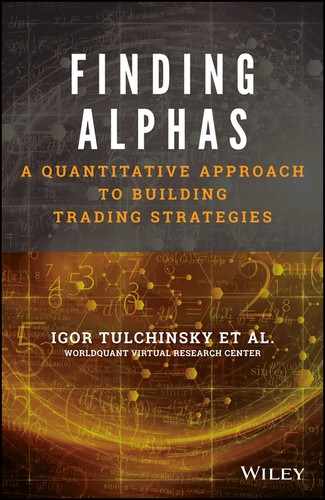18
Algorithms and Special Techniques in Alpha Research
By Sunny Mahajan
Alpha research involves processing vast amounts of raw data. Several algorithms and techniques from engineering disciplines such as machine learning and digital signal processing can be leveraged to extract useful patterns, relationships, and features for alpha generation.
We frequently deal with weak classifiers/predictors in alpha research. The concept of boosting, from machine learning, can be utilized in many cases to create a strong learner out of several weak learners, by learning a suitable weighting function over the weak learners.
Alpha research also involves working with time series data. The concept of filtering, from digital signal processing, is useful in denoising time series data and decomposing time series into trend and cycle components.
Another technique of interest in alpha research is that of feature extraction. Algorithms such as principal component analysis (PCA) help to reduce the dimensionality of the feature space.
Now, let us look at each of these techniques individually to determine their use in generating alpha.
BOOSTING
Boosting is based on the idea of creating a highly accurate prediction rule by combining many relatively weak and inaccurate rules. One of the most widely studied and used boosting algorithms is AdaBoost, as discussed by Freund and Schapire (1999).
AdaBoost learns a strong classifier by combining several weak classifiers using a weighing function, which is learned iteratively. In each iteration, the subsequent weak classifiers are rewarded for classifying correctly those instances that were misclassified by previous classifiers. As long as the performance of each of the individual classifiers is slightly better than random guessing, the final model can be proven to converge to a strong classifier.
DIGITAL FILTERING
Digital filtering involves performing mathematical operations on the raw time series to attenuate or amplify certain characteristics of the signal.
The first and foremost application of digital filtering is smoothing (i.e. suppressing the high-frequency components in the time series). The simplest and most widely used digital filter is the simple moving average. However, smoothing introduces lag, and lag in trading can be extremely unprofitable. As such, alternative filtering techniques can be leveraged to achieve the required level of smoothing with minimum lag.
Another popular application of digital filtering is to decompose the time series into trend and cycle components, as discussed by Mohr (2005). Trend extraction involves suppressing high-frequency components (low-pass filtering), while cycle extraction involves suppressing low-frequency components (high-pass filtering).
A popular and effective filter for low-pass filtering is the Butterworth filter (Butterworth, 1930). High-pass filtering can be accomplished by subtracting the low-pass-filtered time series from the raw time series. Also, low-pass and high-pass frequency filters can be cascaded to select (band pass) or reject (band stop) a specific band of frequencies in the raw time series.
FEATURE EXTRACTION
Feature extraction transforms the data in the high-dimensional space to a space of fewer dimensions. A popular feature extraction algorithm in quantitative finance is PCA.
PCA is an orthogonal linear transformation that transforms the data to express it in terms of new basis vectors – such that these basis vectors explain most of the variance of the original data.
Applications of PCA in alpha research involve finding patterns in data of high dimension, clustering observations (using distance between projections on the new basis as a measure of similarity), principal component regression, and yield curve analysis.
